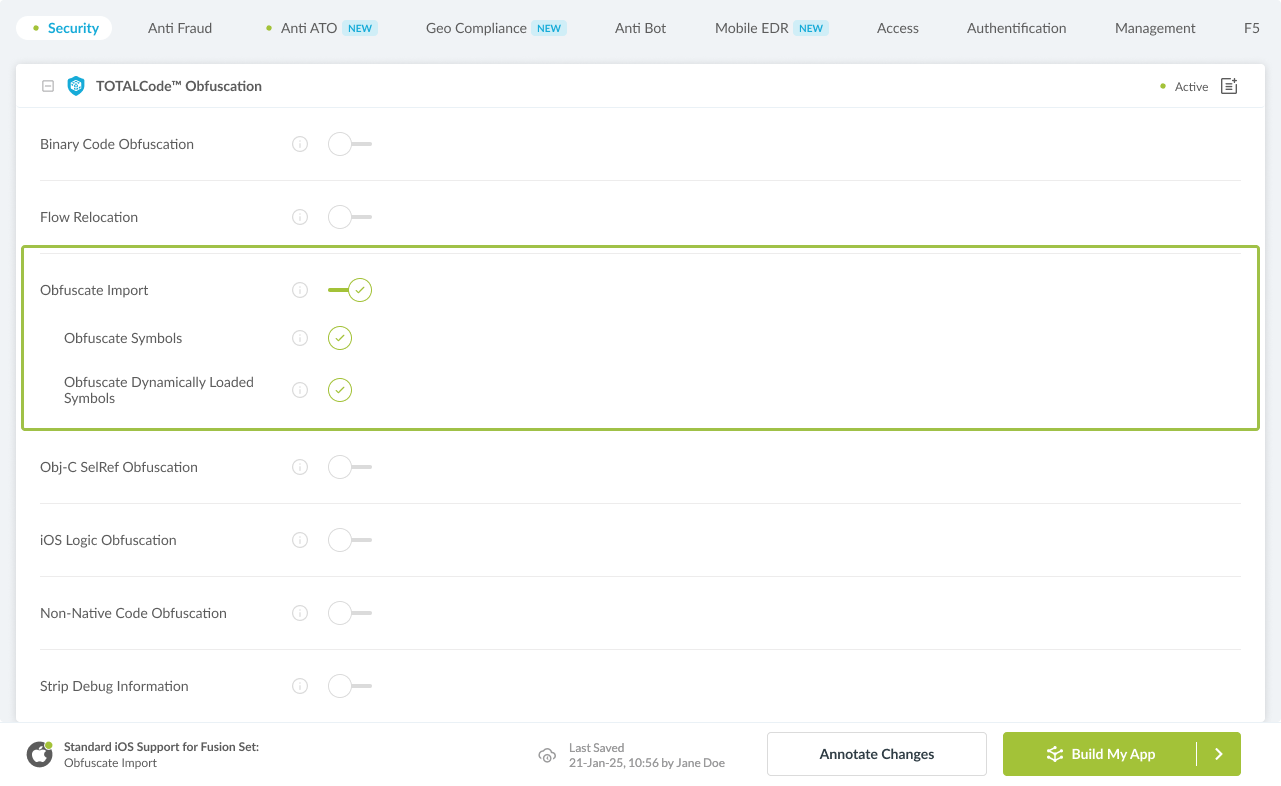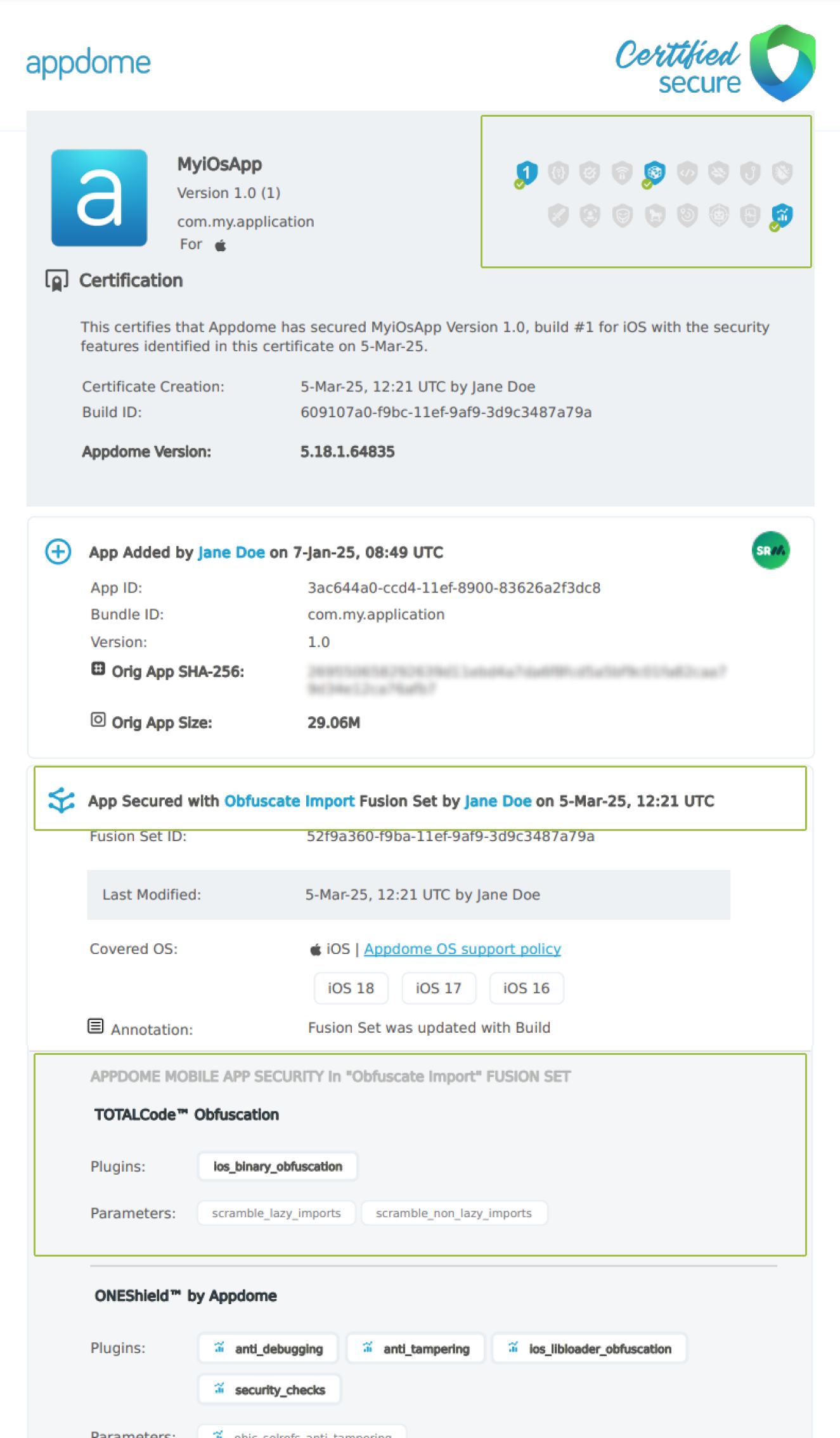How to Obfuscate Import in iOS Apps Using AI
This Knowledge Base article describes how to use Appdome’s AI/ML in your CI/CD pipeline to continuously deliver plugins that Add Obfuscate Import in iOS apps.
What Is Obfuscate Import?
iOS Obfuscate Import involves obfuscating the “Binding Information” in an app’s Mach-O binary format. Binding information is crucial for dynamic resolution of system symbols that the app requires to function, such as calling functions from system libraries. The binding instructions tell the operating system how to resolve these symbols at runtime. Without obfuscation, attackers can use binding information during static analysis or reverse engineering to identify system functions called by the app, thereby gaining insights into the app’s business logic and potential attack vectors. Obfuscating this information renders the instructions incomprehensible to attackers, complicating their ability to reverse engineer the app. Obfuscating these details protects sensitive operations and mitigates potential risks such as code tampering, unauthorized access, or data theft, as well as helping to comply with industry standards like OWASP MASVS.
How Appdome Protects Mobile Apps with Obfuscate Import?
Appdome’s dynamic iOS Obfuscate Import plugin obfuscates binding instructions in the Mach-O binary, preventing attackers from identifying system function calls during static analysis. This protection ensures the app’s sensitive operations and logic remain secure, mitigating reverse engineering risks. By dynamically obfuscating binding details without requiring code changes, the plugin safeguards app functionality and complies with industry standards.
Prerequisites for Using Appdome's Obfuscate Import Plugins:
To use Appdome’s mobile app security build system to Add Obfuscate Import , you’ll need:
- Appdome account (create a free Appdome account here)
- A license for Obfuscate Import
- Mobile App (.ipa for iOS)
- Signing Credentials (see Signing Secure Android apps and Signing Secure iOS apps)
How to Implement Add Obfuscate Import in iOS Apps Using Appdome
On Appdome, follow these 3 simple steps to create self-defending iOS Apps that Add Obfuscate Import without an SDK or gateway:
-
Designate the Mobile App to be protected.
-
Upload an app via the Appdome Mobile Defense platform GUI or via Appdome’s DEV-API or CI/CD Plugins.
-
iOS Formats: .ipa
-
Obfuscate Import is compatible with: Obj-C, Java, Swift, Flutter, React Native, Unity, Xamarin, Cordova and other iOS apps.
-
-
Select the defense: Obfuscate Import.
-
-
Follow the steps in Sections 2.2-2.2.2 of this article to add the Obfuscate Import feature to your Fusion Set via the Appdome Console.
-
When you select the Obfuscate Import you'll notice that the Fusion Set you created in step 2.1 now bears the icon of the protection category that contains Obfuscate Import.

Figure 2: Fusion Set that displays the newly added Obfuscate Import protection
Note: Annotating the Fusion Set to identify the protection(s) selected is optional only (not mandatory). -
Open the Fusion Set Detail Summary by clicking the “...” symbol on the far-right corner of the Fusion Set. Copy the Fusion Set ID from the Fusion Set Detail Summary (as shown below):

Figure 3: Fusion Set Detail Summary
-
Follow the instructions below to use the Fusion Set ID inside any standard mobile DevOps or CI/CD toolkit like Bitrise, Jenkins, Travis, Team City, Circle CI or other system:
-
Refer to the Appdome API Reference Guide for API building instructions.
-
Look for sample APIs in Appdome’s GitHub Repository.
-
Create and name the Fusion Set (security template) that will contain the Obfuscate Import feature as shown below:
Figure 1: Fusion Set that will contain the Obfuscate Import feature
-
-
Add the Obfuscate Import feature to your security template.
-
Navigate to Build > Security tab > TOTALCode™ Obfuscation section in the Appdome Console.
-
Toggle On Obfuscate Import.

Figure 4: Selecting Add Obfuscate Import
Note: The Appdome Platform displays the Mobile Operation Systems supported by each defense in real-time. For more details, see our OS Support Policy KB. -
Configure the User Experience Options for Obfuscate Import:
With Threat-Events™ OFF, Appdome provides several user experience options for mobile brands and developers.- App Compromise Notification: Customize the pop-up or toast Appdome uses to notify the user when a threat is present while using the protected mobile app.
- Short message Option. This is available for mobile devices that allow a banner notification for security events.
-
Localized Message Option. Allows Appdome users to support global languages in security notifications.

Figure 5: Default User Experience Options for Appdome’s Obfuscate Import
-
Obfuscate Import Threat Code™. Appdome uses AI/ML to generate a unique code each time Obfuscate Import is triggered by an active threat on the mobile device. Use the code in Appdome Threat Resolution Center™ to help end users identify, find and resolve active threats on the personal mobile devices.
-
Congratulations! The Obfuscate Import protection is now added to the mobile app -
-
Certify the Obfuscate Import feature in iOS Apps
After building Obfuscate Import, Appdome generates a Certified Secure™ certificate to guarantee that the Obfuscate Import protection has been added and is protecting the app. To verify that the Obfuscate Import protection has been added to the mobile app, locate the protection in the Certified Secure™ certificate as shown below:

Figure 6: Certified Secure™ certificate
Each Certified Secure™ certificate provides DevOps and DevSecOps organizations the entire workflow summary, audit trail of each build, and proof of protection that Obfuscate Import has been added to each iOS app. Certified Secure provides instant and in-line DevSecOps compliance certification that Obfuscate Import and other mobile app security features are in each build of the mobile app.
Using Appdome, there are no development or coding prerequisites to build secured iOS Apps by using Obfuscate Import. There is no SDK and no library to code or implement in the app and no gateway to deploy in your network. All protections are built into each app and the resulting app is self-defending and self-protecting.
Releasing and Publishing Mobile Apps with Obfuscate Import
After successfully securing your app by using Appdome, there are several available options to complete your project, depending on your app lifecycle or workflow. These include:
- Customizing, Configuring & Branding Secure Mobile Apps.
- Deploying/Publishing Secure mobile apps to Public or Private app stores.
- Releasing Secured Android & iOS Apps built on Appdome.
Related Articles:
- Dex Control Flow Relocation, Anti-Reversing for Android Apps
- How to Remove Debug Information, Anti-Reversing Android & iOS Apps
- Binary Code Obfuscation, Anti-Reversing – Android & iOS
How Do I Learn More?
If you have any questions, please send them our way at support.appdome.com or via the chat window on the Appdome platform.
Thank you!
Thanks for visiting Appdome! Our mission is to secure every app on the planet by making mobile app security easy. We hope we’re living up to the mission with your project.
